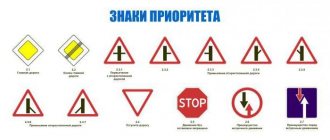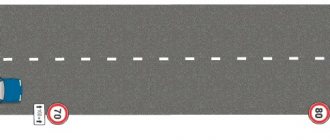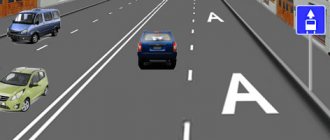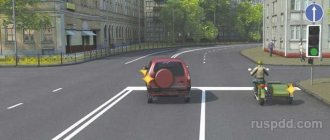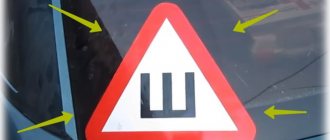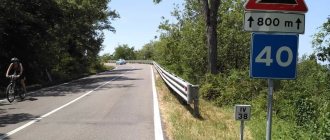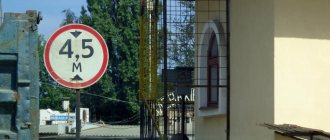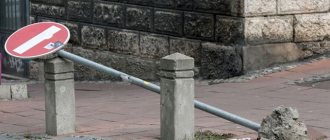Road sign requirements 1.16
The “Rough Road” sign warns motorists of the possible risk of collision with other road users, as well as wear or damage to the vehicle’s suspension.
The first thing the sign requires is to maintain a safe speed. The second is to be ready to go around an obstacle or slow down.
A common mistake made by drivers is to brake sharply in front of a vehicle behind them, which results in a collision. However, in a little-known area or at night, the driver cannot know for sure the road surface.
This is why the installation of sign 1.16 is provided, so that at any moment the steering wheel or braking force can react to an unevenness on the road.
To correct the situation with damage to roads by multi-ton trucks, the legislation of the Russian Federation has introduced a fee per kilometer for heavy trucks over 12 tons. This will keep the roads in good condition according to the meaning of our legislator. Well, we'll wait and see.
Sign on traffic rules tickets
At what distance to an uneven section of the road is this sign installed outside a populated area?
More details
At what distance to an uneven section of the road is this sign installed outside a populated area?
More details
Warning signs are those categories of road signs whose task is to warn road users that they have reached a dangerous section of the road, while driving through which certain measures must be taken that will be appropriate to the situation. Warning signs are some kind of illustration of the main reason that makes a section of the road unsafe, for example, when approaching a railway crossing without a barrier, you will see a traffic warning sign with a picture of a locomotive on it. Some warning signs may notify the driver that he should slow down, some will call for attention, and some will even force him to stop.
Depending on the level of danger, warning Sign 1.16 - Rough Road is posted at different distances from the immediate dangerous section of the road. Certain signs are installed much earlier so that the driver has time to prepare for a certain maneuver or action. Also, the distance at which warning signs are installed depends on whether they are located in a populated area or not. So, outside populated areas, signs can be located 150-300 meters from the dangerous area, and in populated areas 50-100 meters away.
Warning signs are one of the most important categories of road signs, as they are a warning of a real-life danger. Failure to observe and heed warning signs can lead to dire consequences, including death, so you should be aware of them and always pay attention to them on the road.
Rules for installing a sign 1.16
The unevenness of the road can be associated with undulations, potholes, and not smooth connections with the bridge structure. In this case, in accordance with the provisions of GOST, it is necessary to install warnings.
The “Rough Road” sign is installed immediately in front of the uneven area. If this area is located in the city, then the warning will be valid at a distance of 50-100 meters, outside the city at a distance of 150-300 meters, and also at another distance in accordance with the sign on plate 8.1.1.
When carrying out repair work in the area where the said work is being carried out, there may be uneven roads, about which temporary warning signs 1.16 may be placed before entering. The difference between a permanent sign and a temporary sign will be the change of the sign image to a yellow background, which will be temporary.
The effect of the sign will extend to the nearest intersection; if the road remains uneven, sign 1.16 will be duplicated after the intersection.
In any case, the driver must be warned of the danger, since timely warnings ensure traffic safety for motor vehicles.
Explanation
This sign, installed on the side of the road, warns of various road defects and difficulties that a motorist may encounter: these could be holes, potholes or ruts. Its geometry and colors are standard and characteristic of a warning sign: a white triangle with a red border. The image of the unevenness itself is made in black and somewhat resembles a wave.
Sign 1.16 is set
In a populated area: at a distance of 50-100 meters before the start of a rough road.
Outside the populated area: at a distance of 150-300 meters before the start of a rough road.
Outside the populated area, this sign is installed together with the following signs:
1.25 – Road works.
The sign indicates that road work is being carried out. As a result of road works, the road may be uneven. When installing sign 1.25, sign 1.16 must be on a yellow background.
8.2.1 – Coverage area.
Indicates the length of a dangerous section of the road, in this case an uneven road surface.
Coverage area
It is important for the driver not only to have information about the presence of problem areas on the road, but also to know when to expect them. According to traffic regulations, if a disadvantaged area is located within the city, then the sign is located 50-100 meters before it. Outside the populated area, the “Rough Road” sign is installed at a distance of 150-300 meters. Next to the sign there may be a plate 8.1.1 or 8.2.1 containing other information about the distance to the poor-quality road surface or the length of validity of this sign, respectively.
The effect of the warning sign in question extends to the nearest intersection and is duplicated after it if the road continues to be uneven.
In the event that the irregularities are associated with repair work, a warning sign is also mandatory before entering such an area; it is temporary in nature and is located on a yellow background in combination with warning 1.25 “Road Works”.
Sign 1.16 – “Rough road” with sign 8.2.1 – “Area of action”
Coverage area
It is important for the driver not only to have information about the presence of problem areas on the road, but also to know when to expect them. According to traffic regulations, if a disadvantaged area is located within the city, then the sign is located 50-100 meters before it. Outside the populated area, the “Rough Road” sign is installed at a distance of 150-300 meters. Next to the sign there may be a plate 8.1.1 or 8.2.1 containing other information about the distance to the poor-quality road surface or the length of validity of this sign, respectively.
The effect of the warning sign in question extends to the nearest intersection and is duplicated after it if the road continues to be uneven.
In the event that the irregularities are associated with repair work, a warning sign is also mandatory before entering such an area; it is temporary in nature and is located on a yellow background in combination with warning 1.25 “Road Works”.
Sign 1.16 - “Rough Road” with plate 8.2.1 - “Area of Operation”
Liability for violation of sign 1.16
Administrative legal acts do not provide for penalties for violation of the requirements of sign 1.16. But if the driver ignores the warning measures, it will negatively affect traffic safety. A rut can throw a car into the oncoming lane, which will inevitably cause a collision with an oncoming car.
According to traffic accident statistics, a head-on collision often leads to serious consequences for drivers and passengers. And if there is a truck in the oncoming lane, this can have fatal consequences for the driver who flies into the oncoming lane under the wheels of the truck.
The driver faces a fine for speeding. If he is moving in urban conditions, then his speed should not exceed 60 km/h, outside the city no more than 90 km/h. Unfortunately, road sign 1.16 is not always linked to the speed limit in accordance with the requirements of sign 3.24.
It is advisable to set the speed limit to 40 km/h on rough roads. This will avoid an accident and will be proof that the driver violated the speed limit and ignored the requirements of the road with uneven surfaces.
A common road problem is the appearance of ruts caused by heavy trucks. When you get into a rut, the car becomes difficult to control, especially with wide tires. And if this happens at speed, it can lead to driving into a ditch or into oncoming traffic.
Fines
The “Rough Road” sign, warning about an unfavorable section of the road, first of all, instructs the driver to be especially vigilant and drive at a speed that will allow, if necessary, to brake in time, without resorting to emergency braking.
The legislator has not established administrative liability for ignoring a warning about unevenness on the road, but a careless attitude towards the warning can have a detrimental effect on road safety. It is in the driver's interest to heed warning signs, even if failure to observe them does not directly entail liability, and to be especially careful and slow down whenever possible, because otherwise any rut or other defect in the road surface can lead to serious consequences for the driver, passengers and others. persons
Emergency braking performed at high speed on rough roads can result in the loss of a wheel, muffler, or other serious damage to the vehicle.
Sometimes, in a road work zone, the sign in question complements the established temporary speed limit, but even in this case, the violation will concern the sign that directly obliges the speed limit.
Fines
The “Rough Road” sign, warning about an unfavorable section of the road, first of all, instructs the driver to be especially vigilant and drive at a speed that will allow, if necessary, to brake in time, without resorting to emergency braking.
The legislator has not established administrative liability for ignoring a warning about unevenness on the road, but a careless attitude towards the warning can have a detrimental effect on road safety. It is in the driver's interest to heed warning signs, even if failure to observe them does not directly entail liability, and to be especially careful and slow down whenever possible, because otherwise any rut or other defect in the road surface can lead to serious consequences for the driver, passengers and others. persons
Emergency braking performed at high speed on rough roads can result in the loss of a wheel, muffler, or other serious damage to the vehicle.
Sometimes, in a road work zone, the sign in question complements the established temporary speed limit, but even in this case, the violation will concern the sign that directly obliges the speed limit.
Malfunctions caused by poor quality roads
The parts most susceptible to damage from potholes and road obstacles are the suspension and steering components. The chassis, which is in good condition, effectively smooths out unevenness, dampens vibrations and lateral swings of the car body. If the amplitude of vibrations exceeds the value for which shock absorbers and other components are designed, breakdowns occur on the body, which are felt by impacts and characteristic noise. In such a situation, all suspension elements are subjected to increased loads and therefore wear out intensively.
After careless driving on a bumpy road, car owners may experience the following damage to chassis parts:
- delamination and cracking of silent blocks;
- spring sagging;
- shock absorbers leaking;
- wear of hinge joints;
- backlash of steering tips, etc.
Faulty suspension parts must be replaced to avoid damage to interacting elements. You can extend the service life of components and minimize damage if you follow the advice of experienced drivers on driving over uneven road surfaces.
What are the consequences of falling into holes?
Firstly, there is a risk of damaging the car. The wheels that are hit first are the wheels and tires that can be damaged. “Hernias” may appear on the latter, and sometimes it even leads to a side cut. There is also a possibility of damage to suspension and steering components. Even if everything seems to be in order immediately after a strong impact, after some time you may encounter play in the ball joint or steering tip, and sometimes this turns out to be a consequence of that very bump.
Secondly, getting into a hole, especially in a turn, threatens the risk of losing control of the car - it can turn around, turn, or rearrange. In addition, trying to avoid a pothole can cause a loss of directional stability. All this is already fraught with an emergency situation.
